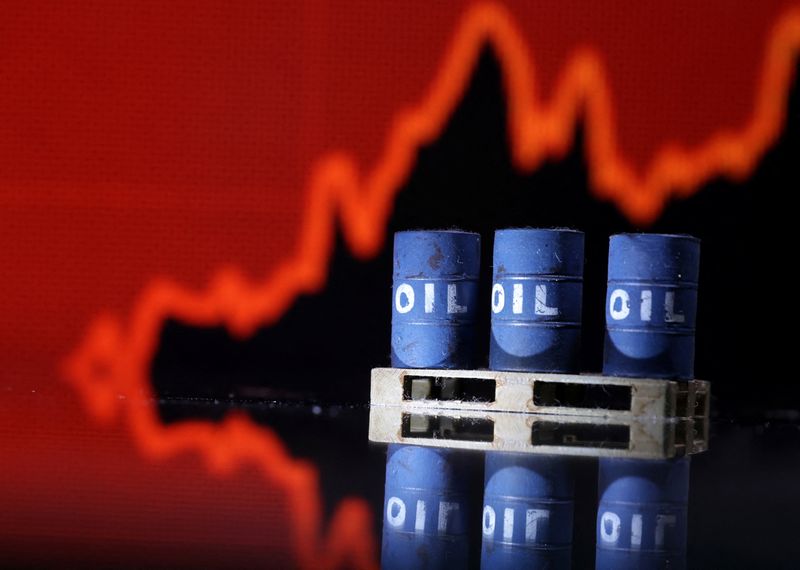Commodities
Oil jumps 4% as tankers avoid Red Sea after strikes


© Reuters. Model of Oil barrels are seen in front of rising stock graph in this illustration, July 24, 2022. REUTERS/Dado Ruvic/Illustration/File Photo
By Paul Carsten
LONDON (Reuters) – Oil prices leaped 4% on Friday, as oil tankers diverted course from the Red Sea following overnight air and sea strikes by the United States and Britain on Houthi targets in Yemen after attacks on shipping by the Iran-backed group.
Witnesses in Yemen confirmed explosions throughout the country.
futures were up $3.16, or 4.1%, at $80.57 a barrel at 1124 GMT, while U.S. West Texas Intermediate crude futures climbed $3.05, or 4.2%, to $75.07.
Both benchmarks were on course for a second straight weekly rise.
The U.S. and UK strikes added to market concerns about the Israel-Hamas war widening into a broader conflict in the Middle East affecting oil supplies from the region, especially those moving through the critical Strait of Hormuz.
“If a large part of Strait of Hormuz flows were to be halted, it would present up to three times the impact of the 1970s oil price shocks and over double the impact of the Ukraine war on gas markets, atop already fragile supply chains and stock levels,” said Saul Kavonic, an energy analyst at MST Marquee.
ING analysts in a note said more than 20 million barrels/day of oil move through the Strait of Hormuz, equivalent to around 20% of global consumption.
U.S. President Joe Biden said the “targeted strikes” in Yemen were a clear message that the United States and its partners will not tolerate attacks on its personnel or “allow hostile actors to imperil freedom of navigation”.
A Houthis spokesperson said the group would continue to target shipping heading towards Israel.
Saudi Arabia, a top oil exporter and regional power, called for restraint and “avoiding escalation” and said it was monitoring the situation with great concern.
Attacks by the Houthis in the Red Sea have disrupted international commerce on a route between Europe and Asia which accounts for about 15% of the world’s shipping traffic.
The Houthis have attacked commercial vessels in the Red Sea to show support for Palestinian militant group Hamas in its fight against Israel.
Shipping giant Maersk and others are diverting vessels away from the Red Sea, warning customers of further disruptions.
The U.S.-led attacks follow Iran’s seizure on Thursday of a tanker carrying Iraqi crude destined for Turkey south of the Strait of Hormuz.
Commodities
Oil prices rise; U.S. crude inventories plunge, Russia-Ukraine truce eyed
Commodities
India’s Reliance to stop buying Venezuelan oil over US tariffs, sources say
Commodities
Oil prices climb on Venezuela supply worries

 Forex3 years ago
Forex3 years agoForex Today: the dollar is gaining strength amid gloomy sentiment at the start of the Fed’s week

 Forex3 years ago
Forex3 years agoUnbiased review of Pocket Option broker

 Forex3 years ago
Forex3 years agoDollar to pound sterling exchange rate today: Pound plummeted to its lowest since 1985

 Forex3 years ago
Forex3 years agoHow is the Australian dollar doing today?

 Cryptocurrency3 years ago
Cryptocurrency3 years agoWhat happened in the crypto market – current events today

 World3 years ago
World3 years agoWhy are modern video games an art form?

 Commodities3 years ago
Commodities3 years agoCopper continues to fall in price on expectations of lower demand in China

 Economy3 years ago
Economy3 years agoCrude oil tankers double in price due to EU anti-Russian sanctions























